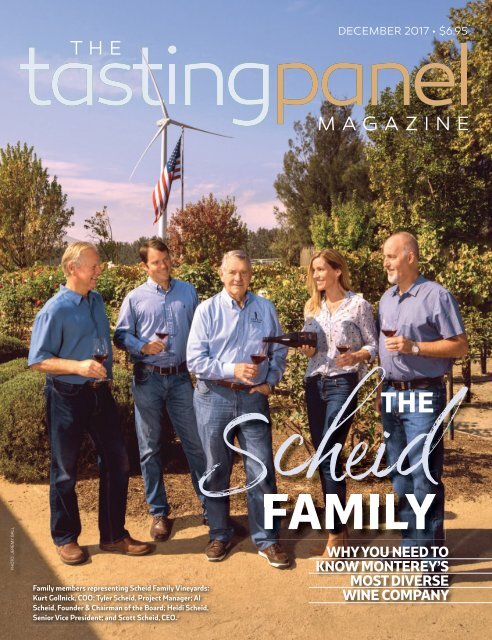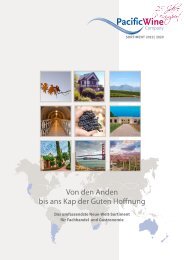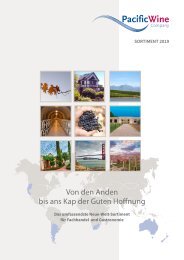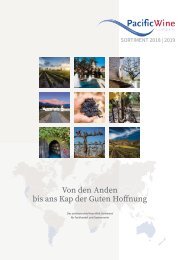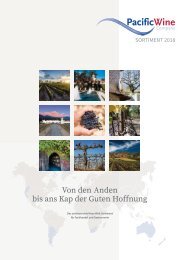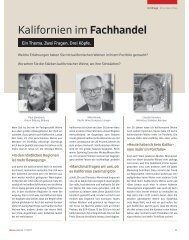You also want an ePaper? Increase the reach of your titles
YUMPU automatically turns print PDFs into web optimized ePapers that Google loves.
DECEMBER <strong>2017</strong> • $6.95<br />
Scheid<br />
THE<br />
PHOTO: JEREMY BALL<br />
Family members representing Scheid Family Vineyards:<br />
Kurt Gollnick, COO; Tyler Scheid, Project Manager; Al<br />
Scheid, Founder & Chairman of the Board; Heidi Scheid,<br />
Senior Vice President; and Scott Scheid, CEO.<br />
FAMILY<br />
WHY YOU NEED TO<br />
KNOW MONTEREY’S<br />
MOST DIVERSE<br />
WINE COMPANY
COVER STORY<br />
Ingenious<br />
GENEALOGY<br />
THE SCHEID FAMILY, THEIR EXTENSIVE<br />
MONTEREY VINEYARDS AND POWERFUL,<br />
INNOVATIVE WINERY<br />
by Jessie Birschbach / photos by Jeremy Ball<br />
Before I really dive into<br />
this story, I want to make sure you understand one<br />
thing—the Scheids make damn good wine. My first<br />
sip ever of the velvety, savory, and bright Scheid<br />
Vineyards Reserve Pinot Noir stopped me dead in<br />
my tracks. <strong>The</strong> District 7 (a label from the Scheid<br />
portfolio) Chardonnay is a wine director’s by-theglass<br />
dream come true that overdelivers on price,<br />
especially as a genuine representation of Monterey.<br />
When a group of high-level Angeleno somms<br />
encountered the Scheid Vineyards 667 Pinot Noir<br />
at a recent Tasting <strong>Panel</strong> blind tasting, they all<br />
immediately knew it was Pinot Noir: a tribute to<br />
the wine’s typicity. With terms like “pretty and<br />
Scheid’s<br />
400-foot-high<br />
wind turbine<br />
generates 100<br />
percent of the<br />
winery’s power.<br />
58 / the tasting panel / december <strong>2017</strong>
<strong>The</strong> Scheid Vineyards 2013 Reserve<br />
Pinot Noir from Monterey: a blend of<br />
the estate’s best barrels of single clone<br />
Pinot Noir aged 20 months in 100%<br />
French oak (80% new).<br />
unencumbered,” “great structure and<br />
complexity,” and “racy, savory, and<br />
delicate” appearing in their tasting<br />
notes, there’s no question—and this<br />
former somm and current senior wine<br />
editor concurs—that the Scheids make<br />
great wine.<br />
But that’s not what this story is<br />
about. It’s about a family—an extraordinarily<br />
business-savvy family—and<br />
the Monterey-based grape-growing,<br />
winemaking empire they have toiled<br />
to build. Whether it was intentional or<br />
unintentional, I’ll let you decide…<br />
THE PLANNED ACCIDENTAL<br />
BEGINNINGS<br />
Founder & Chairman of the Board Al<br />
Scheid will be the first to tell you the<br />
Scheid Vineyards origin story is not the<br />
most glamourous. Established in 1972<br />
as the Monterey Farming Corporation,<br />
the company was originally the general<br />
partner of several limited partnerships<br />
in which vineyard ownership in<br />
Monterey served as a tax shelter for<br />
its investors. Al, the one setting up the<br />
partnerships at the time, ended up also<br />
having to run the company.<br />
For a decade and a half, the<br />
Monterey Farming Corporation would<br />
sell all of its fruit to other wineries; at<br />
one point, the company was responsible<br />
for farming roughly 6,000 acres. It<br />
was during this time, however, that Al began to think ahead to<br />
an uncertain future. “I woke up one day—this was in the ’80s—<br />
and realized someday these people are all going to sell out,” he<br />
recalled. “<strong>The</strong>y’re going to force me to sell the property by vote;<br />
they’re going to try and find someone to buy individual units;<br />
or they’ll try to throw me out and force a sale that way. That’s<br />
when I decided I had better start making plans.”<br />
Al began buying partners out every year using what money<br />
he had saved, and by January 2, 1997, “we owned it all,” he said.<br />
Al then renamed the company Scheid Vineyards as the acreage<br />
under vine fluctuated, landing on the final number of 4,000<br />
acres representing what he described as “the choicest properties<br />
of all the properties we had.”<br />
Noted viticulturalist Kurt Gollnick, formerly of Bien Nacido<br />
Vineyards, started with the company as the General Vineyard<br />
Manager in 1988. Now the COO, he told the Tasting <strong>Panel</strong><br />
about some of the strategies the Scheid team had to develop<br />
and execute as the world around them—and the company<br />
itself—evolved: addressing phylloxera in the ’90s, as well as the<br />
oversupply of wine; upgrading the vineyard; designing and<br />
building a winery; producing wine for others; and, of course,<br />
finally making and selling wine themselves. “When we decided<br />
to build the winery, we literally went all in,” Gollnick said. “We<br />
<strong>The</strong> Scheid family and<br />
COO Kurt Gollnick<br />
drop in on a custom<br />
crush grape delivery.<br />
december <strong>2017</strong> / the tasting panel / 59
COVER STORY<br />
Al Scheid watches<br />
as his son Tyler<br />
gives a punch-down<br />
demonstration in the<br />
open top fermenter.<br />
“LUXURY WINEMAKING<br />
ON A LARGE SCALE”<br />
Today Scheid Vineyards consists of<br />
4,000 acres of grapes certified sustainable<br />
by the California Sustainable<br />
Winegrowing Alliance that span<br />
more than 70 miles of the Salinas<br />
Valley. Bejeweled along this lengthy<br />
strip of Monterey wine country are<br />
eleven estate vineyards, all planted<br />
appropriately to four different climate<br />
zones. <strong>The</strong> cooler, breezy Monterey<br />
AVA boasts one of California’s longest<br />
growing seasons. Taking advantage<br />
of this is a 400-foot-high wind turbine<br />
(which generates more than enough<br />
power to cover the winery’s needs)<br />
and 39 different varieties of grapes<br />
planted, not to mention an astonishing<br />
20 different clones of Pinot Noir. That’s<br />
probably one of the reasons why the<br />
Scheid Vineyards Reserve Pinot Noir<br />
is now one of my favorite Pinot Noirs<br />
out of Monterey—they’ve got a lot<br />
of options.<br />
Constructed in phases from 2005,<br />
the winery and bottling operation<br />
offer what multiple employees proudly<br />
describe as “luxury winemaking on a<br />
large scale.” <strong>The</strong> winery processes the<br />
equivalent of 2 million cases annually<br />
and boasts a crush capacity of about<br />
35,000 tons of fermentation. “This<br />
winery really matches the quality of<br />
fruit we have coming from Monterey,”<br />
CEO Scott Scheid said, raising his<br />
60 / the tasting panel / december <strong>2017</strong><br />
leveraged all our resources, as much as<br />
we possibly could, and if that had not<br />
worked out for us we would have found<br />
ourselves liquidating a lot of the assets<br />
and shrinking our management team.<br />
We’d have all been looking for work.<br />
So, there’s been this series of calculated<br />
risks, and I’m really proud to have been<br />
a part of solving those problems by<br />
actually assembling teams that have<br />
made major contributions to all of that.”<br />
In retrospect, Al can’t help but mull<br />
over how things could have unfolded<br />
differently during those early years.<br />
“<strong>The</strong> correct way of getting into this<br />
industry is growing grapes for a minimum<br />
of 20 years before you make any<br />
wine, then once you start making wine,<br />
you should sell it to other wineries,<br />
because they’re heavier task masters<br />
than the consumers,” he explained.<br />
“After you sell the bulk wine to wineries,<br />
you make your own wine, put a<br />
label on it and try to sell it. Distribution<br />
is one thing, but still, at that point there<br />
are a lot of problems behind you. You<br />
know how to grow grapes. You know<br />
how to produce good wine. Now the<br />
trick is to sell, but at least you’ve got a<br />
good product. I wish to God I could say<br />
I sat down and worked out all this stuff,<br />
but I didn’t.”<br />
Metz Road 2015 Chardonnay and 2015<br />
Pinot Noir from the Riverview Vineyard<br />
in Monterey.
voice above the clanking sound of<br />
our shoes on the lofty steel catwalks<br />
as we marched between the large<br />
open top fermenters. “This open top<br />
fermentation is no different than a<br />
small, boutique winemaker with a<br />
four-by-four bin punching it down by<br />
hand,” he said. “In our case though,<br />
we’ve got just a little bit of a hydraulic<br />
assist so you can do six, 12, or even 25<br />
tons at a time.”<br />
Director of Winemaking Dave<br />
Nagengast has been with Scheid since<br />
2002, and says the winery—which<br />
he helped design—takes cues from<br />
small-lot handling to make production<br />
“a very simple process.” “It’s not hands<br />
on, but it’s gentle handling. Everything<br />
that comes through here is handled<br />
very similarly, and we have a lot of<br />
control,” he explains. “We have open<br />
top fermenters for certain varieties for<br />
certain conditions, closed tops, and<br />
[wine pump-over] venturi injectors with<br />
the ability to add air to the fermentation<br />
so the yeasts are happy. We also have<br />
temperature control on everything so<br />
we can control the rates of fermentation<br />
or the storage conditions. <strong>The</strong> approach<br />
is really kind of thinking about things<br />
as a very small, high-end production<br />
winery on a large scale.”<br />
Gollnick adds to the state-of-the-art<br />
list of features in staggering detail<br />
and with great pride, making it obvious<br />
that he really is—as the Scheids<br />
refer to him—“one of the family.” His<br />
blue eyes shimmer as he points to a<br />
sloped-bottom fermentation tank and a<br />
conveyer that looks like a robotic longnecked<br />
dinosaur. “We invented these<br />
tanks, which the manufacturer dubbed<br />
‘the Scheid Slide,’ so we never have<br />
to put an employee in there to shovel<br />
the grapes out,” he said. “Safety is very<br />
important to us.”<br />
We continued to walk through<br />
the city of steely, silver, and round<br />
skyscrapers before stopping in front of<br />
some sort of locomotive. I wondered<br />
where it would take us, but Gollnick<br />
stepped in to explain that this innovation—basically<br />
a “big train” weighing<br />
roughly 250,000 pounds when full—has<br />
the ability to move up and down the<br />
line to each fermenter. “This grape<br />
press on rails is just like other presses<br />
that are in line and immobile, but it has<br />
two doors for loading, although we<br />
always use one,” he added. “<strong>The</strong> advantage<br />
here is that we’re not sluicing. <strong>The</strong><br />
vast majority of wines are made from<br />
sluiced grapes; they literally put a wine<br />
pump into this tank and whip the grape<br />
skins around, whip the seeds around,<br />
and get everything liquified. <strong>The</strong>n they<br />
pump it to the press, but by doing that<br />
they’re literally cutting the skins and<br />
the seeds again and releasing the bitter<br />
tannins. So that’s one of the luxury<br />
sides of this process—we don’t break<br />
the skins and the seeds down, and<br />
I think you get a better wine quality<br />
product right off the bat as a result.”<br />
Scott Scheid and family<br />
give Managing Editor Jessie<br />
Birschbach a tour of the winery.<br />
<strong>The</strong>y’re standing next to the<br />
“Scheid Slide” fermentation tank,<br />
with the press on rails in the<br />
background.<br />
THE SCHEID<br />
ENTREPRENEURIAL SPIRIT<br />
Getting to know the Scheids adds<br />
another level to the concept of a<br />
“family-run business,” because they’re<br />
a family of business-minded individuals.<br />
This is apparent even in what could<br />
be called their extended family, which<br />
is made up of those who have been<br />
part of the company for many years.<br />
Gollnick epitomizes this as an equal<br />
partner in the company, just the same<br />
as Al and his brood. “I have a true love<br />
and affection for the family,” Gollnick<br />
said. He’s also an obsessive farmer—<br />
even farming his own hobby vineyard<br />
at home—but that’s another story.<br />
Al was born into a poor family in the<br />
december <strong>2017</strong> / the tasting panel / 61
COVER STORY<br />
small coal-mining town of Bridgeport,<br />
Ohio, and graduated from Harvard<br />
Business School with an MBA. While<br />
at the helm of the Monterey Farming<br />
Corporation, he also worked as an<br />
investment banker and ran two<br />
biotech companies. I asked Al about<br />
working with his family, to which he<br />
replied, “<strong>The</strong> good news is they joined<br />
the company not under duress or any<br />
pressure from me.”<br />
Scott Scheid may not have had to dig<br />
his way out of the same disadvantages<br />
as his father, but he certainly inherited<br />
Al’s ambition. Tall in stature, Scott<br />
looked down at me with a bit of a smirk<br />
and said, “<strong>The</strong> joke around here is<br />
that I missed my calling and I should<br />
have been an engineer. But I studied<br />
economics instead, and it’s a great<br />
combination here because there’s so<br />
much innovation and engineering that<br />
goes into making quality wine and<br />
getting those grapes into the bottle.”<br />
According to Scott, his father actually<br />
never intended for Scheid to evolve<br />
as a family business; instead, they were<br />
“a finance family who found our way<br />
into a great industry.” Scott was actually<br />
working at E.F. Hutton & Company<br />
primarily as an options trader when<br />
his father called to propose he join<br />
Scheid Vineyards back in 1986. He took<br />
a sabbatical from Wall Street and never<br />
looked back. “My dad’s philosophy that<br />
no matter what, you’ve got to go out<br />
and make your way in the world before<br />
you come back and get into a family<br />
business, has been to the benefit of this<br />
company,” he said.<br />
In fact, Scott notes that some of<br />
the most successful wineries they’ve<br />
observed over the years are run by<br />
“people who came from other places<br />
with other disciplines.” “I think we’ve<br />
made a lot of solid plans, and because<br />
of that we’ve grown with the Monterey<br />
and California industries as needed,”<br />
he explained. “We’ve certainly rolled<br />
the dice, but we’re not gamblers, and<br />
we’ve seen a number of agricultural<br />
companies go out of business by overextending<br />
themselves. That’s where I’m<br />
grateful that we’re finance people who<br />
found their way into farming and wine<br />
grapes, rather than farmers who had<br />
some success and had to learn finance.”<br />
This reminded me of our dinner with<br />
the whole family the night before. It’s<br />
Kurt Gollnick, COO; Al Scheid, Founder and Chairman of the Board; Heidi Scheid,<br />
Senior Vice President; Tyler Scheid, Project Manager; and Scott Scheid, CEO.<br />
here we got to know the youngest,<br />
Tyler Scheid, who works as a Project<br />
Manager at the company. With his<br />
casual demeanor, Tyler seems the<br />
least likely of the Scheids to imbue the<br />
entrepreneurial spirit, but he swiftly<br />
proved me wrong: Our “polite dinner<br />
conversation” revolves around data<br />
collection, analytics, harvest logistics,<br />
and total vertical integration.<br />
“<strong>The</strong>re’s a lot of IT work in what I<br />
do. I work under Kurt, the COO, as the<br />
company has grown into the new lines<br />
of business. When I first started in vineyard<br />
operations in 2011, the company<br />
was just getting into the branded goods<br />
business and finished goods production,<br />
so with that comes a lot of change and<br />
adding onto the business process—you<br />
know, really thinking through setting<br />
62 / the tasting panel / december <strong>2017</strong>
up the company infrastructure to<br />
handle these things,” Tyler said, pausing<br />
occasionally to eat his fish. “<strong>The</strong> systems<br />
infrastructure is part of the foundation<br />
that’s helped to scale up our business.<br />
You basically limit your scalability if<br />
you rely on your old systems to do new<br />
things. In order to play the game, you<br />
have to get into things like advanced<br />
analytics and really understand what<br />
your business is doing for strategic<br />
planning purposes.”<br />
Al would pepper Tyler’s buffet of<br />
information with a relevant story or two<br />
before Tyler eagerly jumped back in to<br />
talk about CellarWatch, the information<br />
portal provided for Scheid’s custom<br />
crush and winery clients. “<strong>The</strong> customers<br />
that use our CellarWatch tell us that<br />
they get better information out of our<br />
portal then they get out of their own<br />
winemaking system because we show<br />
every single cellar operation: all the<br />
racking, the movements, the blending,<br />
custom crush, even pictures of the<br />
grapes when they come in,” he said.<br />
“<strong>The</strong>re’s always been this kind of technology<br />
bent. Innovation and technology<br />
are part of the DNA of this company.”<br />
with a laugh. When I admitted I didn’t<br />
know either, Heidi explained that she’d<br />
used Lotus, a spreadsheet program, so<br />
frequently at Ernst & Young that she<br />
“was kind of the spreadsheet master<br />
back in the day before spreadsheets<br />
were widely being used in businesses.”<br />
<strong>The</strong> dense and dark<br />
Stokes’ Ghost 2014 Petite<br />
Sirah from Monterey.<br />
After that visit—and while still on<br />
maternity leave—Heidi stayed at<br />
Scheid to put all the depreciation and<br />
inventory schedules into the program.<br />
In 1992 she officially came aboard as<br />
Scheid Vineyards’ Director of Planning,<br />
eventually working her way up to<br />
Executive Vice President, and by the<br />
early 2000s, the leadership quadrant at<br />
the company was complete.<br />
Noting the Scheid knack for forecasting<br />
the future, I asked Heidi what was<br />
next for the 45-year-old company.<br />
She responded that they’re “really<br />
focused on a winner”: the company’s<br />
District 7 brand, which is available on<br />
Kroger and Ralphs shelves, Lucky/Save<br />
Mart, Gelson’s, BevMo, and, starting<br />
in January, at Northern California<br />
Safeways. “Nothing in the wine industry<br />
is actually an overnight success. District<br />
7 feels like it’s just kind of hitting that<br />
stride and now it has to prove itself,”<br />
Heidi said. “We think the wine is great,<br />
and we’ve gotten good response on the<br />
package as well. It’s authentic Monterey<br />
at a great price point. We work really,<br />
really hard on wine quality, and we can<br />
sustain that because we source everything<br />
from our estate vineyards. It<br />
feels like it checks off all the right boxes,<br />
but as my marketing professor told<br />
me in graduate school, ‘Ultimately the<br />
market decides.’”<br />
Beyond the growing success of<br />
District 7, Heidi said she’s also “really<br />
<strong>The</strong> current Monterey-based District 7 lineup<br />
from left to right: 2016 Sauvignon Blanc,<br />
2016 Chardonnay, 2015 Pinot Noir, and 2015<br />
Cabernet Sauvignon.<br />
THE FARSIGHTED FAMILY<br />
At the end of our visit to the winery the<br />
next day, I finally sat down with Heidi<br />
Scheid. Although she’s the last Scheid<br />
mentioned here, she’ll be the first to<br />
say hello. As the warmest member<br />
of the family (which is already good<br />
humored) and equally as sharp, Heidi<br />
previously worked as a manager at the<br />
first California Pizza Kitchen in Beverly<br />
Hills. That’s probably why she’s also the<br />
wine savviest of the bunch as a Certified<br />
Specialist of Wine, but it also speaks to<br />
her work ethic. Heidi received her BS<br />
and MBA degrees from the University<br />
of Southern California and worked for<br />
quite some time as a valuation consultant<br />
for Ernst & Young.<br />
After the birth of her first child, Heidi<br />
decided to visit Al and Scott at their<br />
office and noticed something when<br />
she arrived. “Ernie, our controller, had<br />
this big green ledger paper and was<br />
working away with a pencil. I asked<br />
him what he was doing and he said,<br />
‘Depreciation schedules.’ I was like,<br />
‘Why don’t you do that on Lotus?’ and<br />
he said, ‘What’s Lotus?’” Heidi recalled<br />
excited about Metz Road.” “This last<br />
<strong>2017</strong> vintage for the Chardonnay, we<br />
did a native yeast fermentation in the<br />
vineyard, which is great because I love<br />
that Burgundian style of Pinot Noir and<br />
Chardonnay. It’s a higher price point<br />
so we’ll see where that goes,” she said.<br />
Stokes’ Ghost—“100% Petite Sirah<br />
behind a great story”—is another label<br />
to watch. “I think the goal is to just<br />
keep nurturing these core brands in<br />
our portfolio and help them reach their<br />
potential,” Heidi added.<br />
I wondered how the Scheids will<br />
reach that potential—less out of<br />
concern than curiosity, because if<br />
any family has the ability to do so, it’s<br />
them. As if she’d read my mind, Heidi<br />
answered, “We’re always trying to get<br />
distributors to come out here. We can<br />
do the presentation in Ohio or wherever<br />
and show pictures of the tanks and the<br />
open-top fermenters and the vineyards,<br />
and they’ll be convinced we’re believers.<br />
But when you actually hang out<br />
for a day in the vineyard and see the<br />
winery and meet the whole team, you’ll<br />
not only believe it in your mind—you’ll<br />
believe it in your heart.”<br />
december <strong>2017</strong> / the tasting panel / 63


